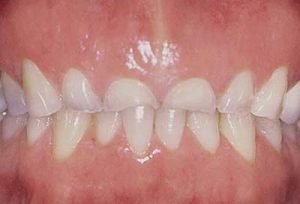
Welcome to a three part series on Composite Resins…
Composite resins are synthetic resins used in dentistry as white filling material.
History of Synthetic Resins
They evolved as a restorative material for their characteristics:
1) Insoluble: They do not dissolve in water.
2) Aesthetic.
3) Insensitive to dehydration.
4) Easy to manipulate.
5) Reasonably inexpensive.
Over the years their compressive strength has improved. Because of this they can be used as filling material for posterior (back) teeth: these ‘back teeth’ are subjected to greater forces and pressure than the front ones. Due to greater compressive strengths, composite resin can have a similar longevity to that of amalgam (silver fillings).
Shrinkage
A past problem with composite resins was their high degree of polymerization shrinkage. But now, this is quite low. This enables it to be ‘placed’ in bulk and as well there is no issue of the resin ‘pulling away’ from the walls of the cavity preparation.
Very Technique Sensitive
When placing white filling material, the tooth must be perfectly dry or else the resin may not adhere to the walls of the cavity preparation.
They are placed into the tooth while soft and dough-like. Then they are exposed to an ultraviolet (UV) light of a blue wavelength (470 nanometers) that causes them to harden or polymerize. When the resin is placed into the tooth (cavity preparation), it should be done in increments of 2-3 mm’s and then cured (hardened) with the light. If the composite is placed in too thick a layer, then the light may not be able to harden the filling material adequately and the deepest layers of it may remain soft. So if a deep filling is placed we need to layer the filling material and shine the light frequently to ensure uniform hardness of it. Note: If the filling material is not cured adequately, then the uncured resin material will leach free monomer which can lead to leakage at the filling/tooth interface which than translates into tooth sensitivity and probable re-decay.
What is the Orange Shield that is used when the UV light is shone?
Many times a patient will ask “what is the orange shield for?” The reason we use this orange shield is because it filters out the harmful UV rays that can be damaging to the assistants and dentist’s eyes if exposed to on a regular basis…it’s the repeated exposure that can be harmful. We also ask the patient to keep their eyes closed when shining the light.
Success of the White Filling
The success of the white filling depends on two important factors:
1) Expertise of the dentist placing it. This is important…as previously mentioned; it is a technique sensitive procedure. The filling material must be placed into dry tooth structure which has been specially prepared with certain bonding agents. The filling material also needs to be placed in layers and each layer needs to be cured with the light. These points are important and this is a technique that requires patience on the dentist’s behalf…..It cannot be rushed and no steps can be left out – there are no short cuts.
2) Oral hygiene of the patient. Again, a very important point. When the patient leaves the appointment, the filling will look optimal because it was just done. However, if it is not kept clean i.e. is covered with plaque and food particles, it will not hold up well. This ‘concept’ is similar to that of a car that is covered with salt in the winter…it will rust. If the filling is covered with plaque, it may not stand the test of time.
3) So an effort has to be made on the patient’s behalf to keep the white filling clean in order to improve its longevity.
In the next couple of blogs, we will look at the advantages and disadvantages of white filling material……in the meantime, keep smiling!
Yours in optimal dental health,
Dr. F. Keshavarz Dentistry, Brampton Dentist







